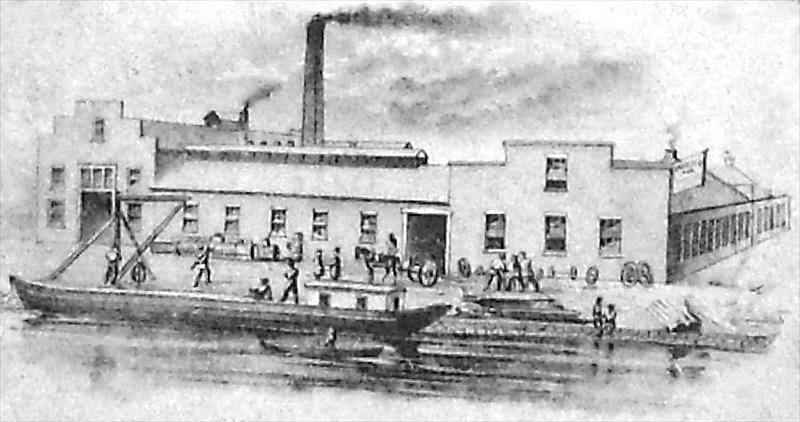 |
| Eagle Iron Works |
This maker of steam engines and sawmills—among other products—was in business by 1851. The business was founded by Philip Rahm. Rahm died during the Civil War and the factory was destroyed by the great fire in Richmond in 1865. After the war, the works were rebuilt in 1866 by Philip Rahm's son, A. J. Rahm, and his former partner and plant superintendent, Frank Kahl. The firm was awarded a Gold Medal of Honour by the United States Department of Agriculture.
By 1871, the business was renamed Rahm & Calder, with partner Humphrey Calder.
Information Sources
- From the Proceedings of the N. Y. State Agricultural Society for 1858:
At the Royal Agricultural Show at Windsor, in 1851... The engine of Philip Rahm, Eagle Machine Works, was a very compact and useful one, and which has had very extensive use among the planters of the South. His arrangement of his heating tubes in a circle was different from the others, and his spark arrester and the arrangement ofr heating the water before it was poured into the boiler, seemed well adapted to prevent danger from explosion or fire. Mr. Rahm was the architect of his own fortune, as we were informed by one of the editors of the Enquirer. From a journeyman in a machine establishment, he, with little capital commenced for himself, and has now, after about fourteen years labor, as we understood, amongthe most valued and extensive establishments at Richmond, supplying engines to all the Southern States and to Brazil. His engines are not complicated, and after a few days instruction the hands upon the plantation, we are assured, manage them without trouble. The three engines examined were very good ones. The Society's Gold Medal, 1st prize, was awarded to Mr. Rahm—a Special Honorary Diploma to the other exhibitors.
- From a circa 1859 catalog. "Manufacturer of portable, strictly portable (ca 1850's) and stationary steam engines, with either cylinder, flue or tubular boilers, sugar mills, saw mills, grist mills, draining machines, circular saw mills, shingle lath and surface planing machine, iron work for Bagasse burners, beef packing machinery, tobacco factory fixtures, presses, screws, flattening mills, sinkers, levers, &c. &c. and machinery of any description, adapted to the southern country, on exhibition and for sale at my warehouse." The catalog contains a plate showing "[Philip] Rahm's Circular Saw Mill" and an Improved circular sawmill.
- A descendant of Philip Rahm's sister writes that "Philip died during the Civil War from lockjaw resulting from a wound incurred while helping his workmen load a wagon. His son, Adolphus, was released from the Confederate Army to run the factory. The factory was destroyed by the great fire that engulfed Richmond at the time of the Confererate evacuation of the city in April 1865." It was rebuilt in 1866.
- The 1874 work, Wiley's American Iron Trade Manual of the Leading Iron Industries of the United States, has this listing: "RAHM & CALDER—Machinery."
-
Steam Power on the American Farm by Reynold M. Wik, 1953 page 253
-
United States Department of Agriculture 1866 Poster